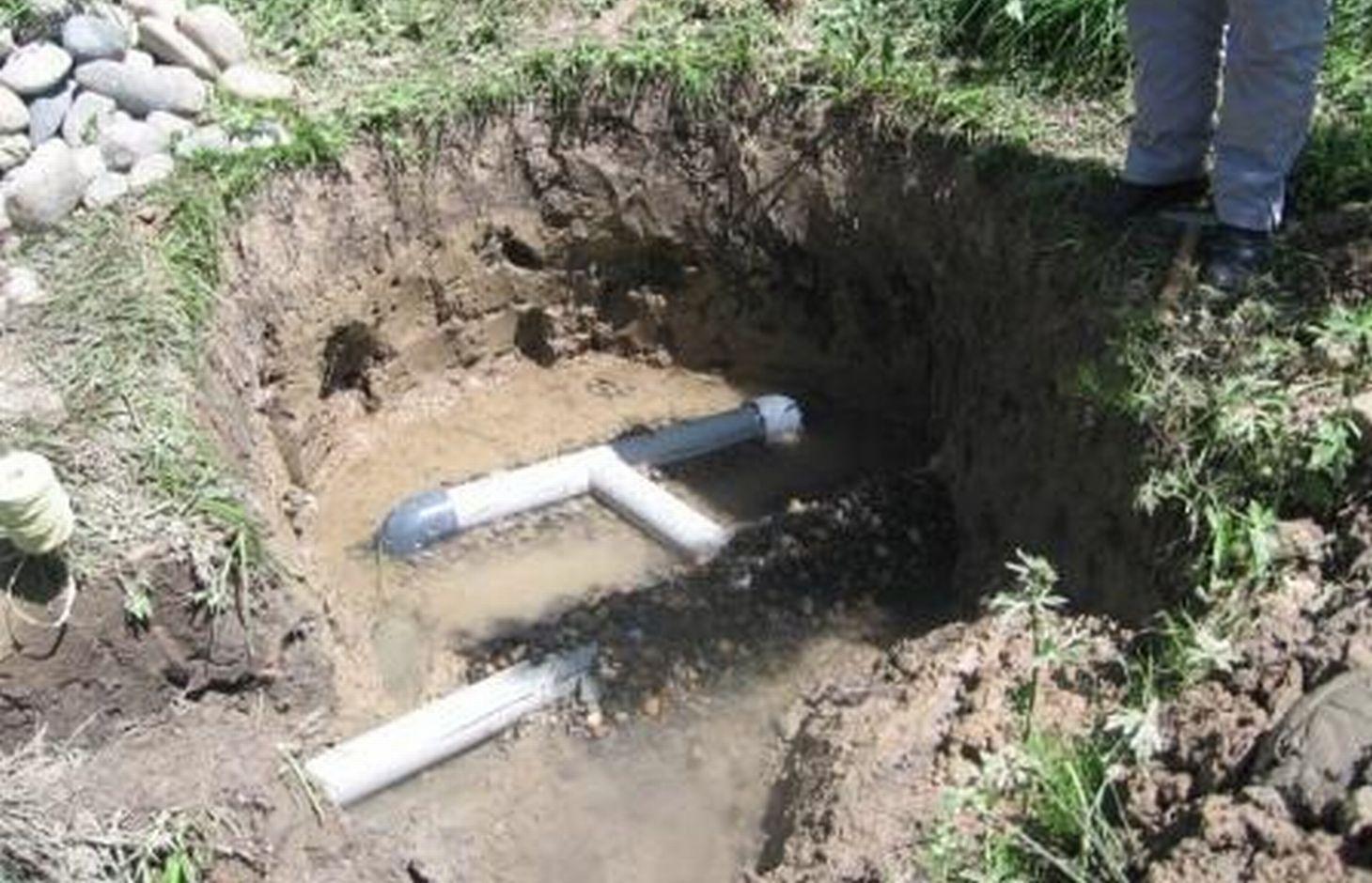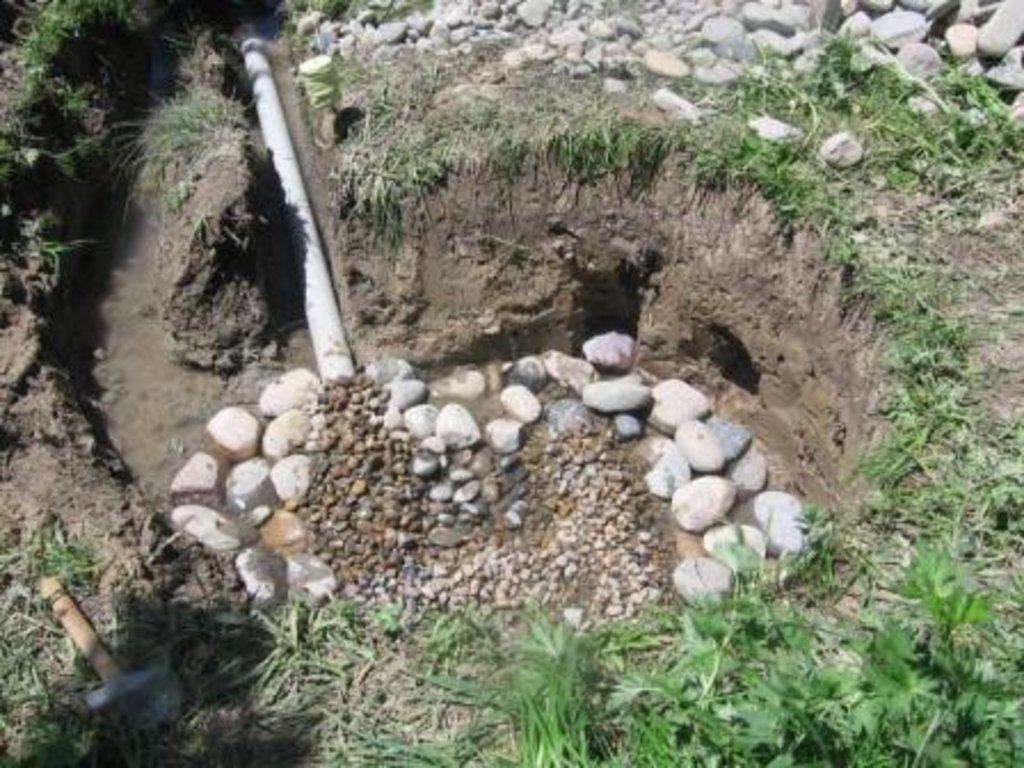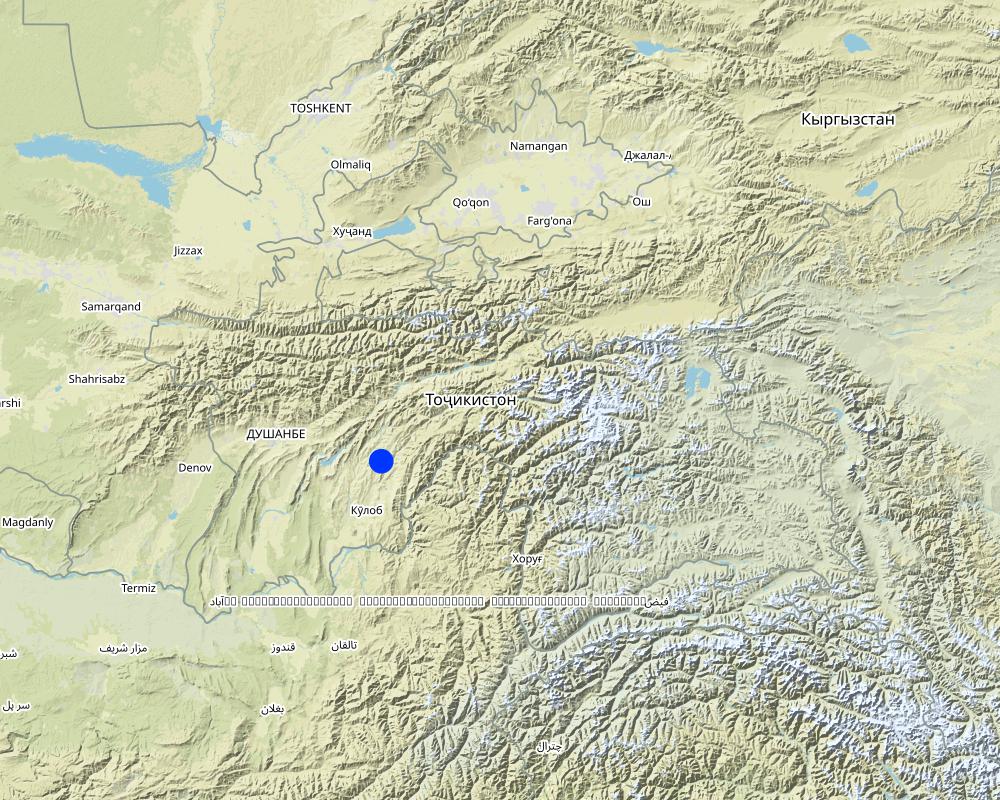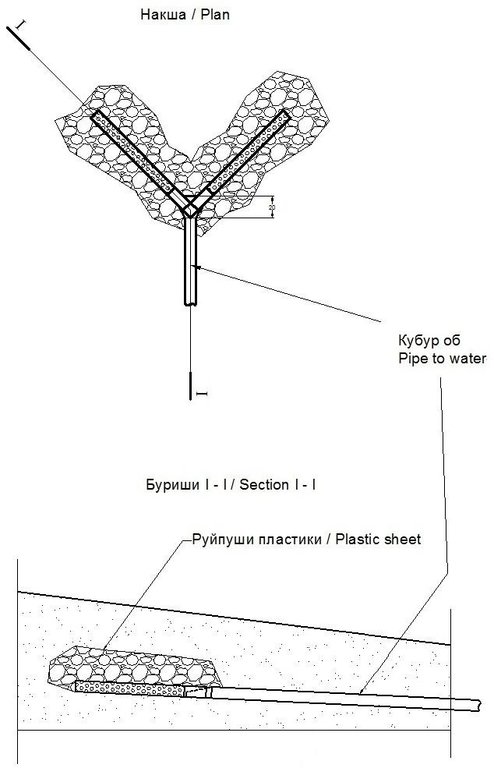Natural spring catchment protection [Tadjikistan]
- Création :
- Mise à jour :
- Compilateur : Giuseppe Bonati
- Rédacteur : –
- Examinateurs : Alexandra Gavilano, David Streiff, Joana Eichenberger
technologies_1465 - Tadjikistan
Voir les sections
Développer tout Réduire tout1. Informations générales
1.2 Coordonnées des personnes-ressources et des institutions impliquées dans l'évaluation et la documentation de la Technologie
Spécialiste GDT:
Nom du projet qui a facilité la documentation/ l'évaluation de la Technologie (si pertinent)
Pilot Program for Climate Resilience, Tajikistan (WB / PPCR)Nom du ou des institutions qui ont facilité la documentation/ l'évaluation de la Technologie (si pertinent)
CESVI (CESVI) - Tadjikistan1.3 Conditions relatives à l'utilisation par WOCAT des données documentées
Le compilateur et la(les) personne(s) ressource(s) acceptent les conditions relatives à l'utilisation par WOCAT des données documentées:
Oui
2. Description de la Technologie de GDT
2.1 Courte description de la Technologie
Définition de la Technologie:
The construction of a natural spring catchment pit for the collection and distribution of uncontaminated ground water.
2.2 Description détaillée de la Technologie
Description:
The technolgy consists of digging of a pit around the spring outlet and placing a 15cm perforated plastic pipe on a bed of gravel. The gravel acts as a natural sediment filter and protects the pipe from clogging. The pipe is buried in more gravel and covered with a plastic sheet to prevent animals from contaminating the spring source. The plastic pipe can be extended and attached to a flexible pipe to deliver clean ground water to the final destination.
Purpose of the Technology: There are two main aims of the technology, the first is to prevent contamination of the spring source from livestock which uses the spring head as a watering hole. The second goal is to optimise the springs capacity for irrigation and human consumption by capturing the water in the perforated pipe and channelling to the usage point.
Establishment / maintenance activities and inputs: The construction of the spring catchment is relatively straight forward. A 1m deep pit is dug around the spring head approximately 2m wide. A bed of washed gravel is placed in the foot of the pit, and a 15cm perforated plastic pipe is embedded into the gravel, this is attached to a flexible tube to transport the clean water away. The perforated pipe is covered in more clean gravel and covered with a heavy polythene sheet and covered in earth. The construction process can be completed in one day if the materials are available.
The only substantial maintenance required would be the cleaning of the pipe and gravel if it gets clogged with earth.
Natural / human environment: In many parts of Tajikistan water for human use and irrigation is scarce and plays a critical role in securing the livelihoods of the local population. The construction of the spring catchment increases not only the volume but also improves the quality of water available. This can and does have a dramatic effect on the productivity of the land and the health of the land users.
2.3 Photos de la Technologie
2.5 Pays/ région/ lieux où la Technologie a été appliquée et qui sont couverts par cette évaluation
Pays:
Tadjikistan
Région/ Etat/ Province:
Khatlon region
Autres spécifications du lieu:
Khovaling
Spécifiez la diffusion de la Technologie:
- répartie uniformément sur une zone
S'il n'existe pas d'informations exactes sur la superficie, indiquez les limites approximatives de la zone couverte:
- < 0,1 km2 (10 ha)
Commentaires:
This technology is in one location.
Map
×2.6 Date de mise en œuvre de la Technologie
Si l'année précise est inconnue, indiquez la date approximative: :
- il y a moins de 10 ans (récemment)
2.7 Introduction de la Technologie
Spécifiez comment la Technologie a été introduite: :
- par le biais de projets/ d'interventions extérieures
Commentaires (type de projet, etc.) :
Spring Protection Project
3. Classification de la Technologie de GDT
3.1 Principal(aux) objectif(s) de la Technologie
- improved access to water
3.2 Type(s) actuel(s) d'utilisation des terres, là où la Technologie est appliquée

Terres cultivées
- Plantations d’arbres ou de buissons
Plantations d'arbres et d'arbustes - Précisez les cultures:
- fruits, autres
Nombre de période de croissance par an: :
- 1
Précisez:
Longest growing period in days: 180Longest growing period from month to month: april - october

Forêts/ bois
Produits et services:
- Bois de chauffage
- Fruits et noix
- Protection contre les aléas naturels
Commentaires:
Major land use problems (compiler’s opinion): Lack of access to water. Contamination of the water due to animals using the spring.
Major land use problems (land users’ perception): Provides a better cleaner source of water for the land and the people.
Plantation forestry: Fruit tree orchards.
Problems / comments regarding forest use: The spring is located in natural woodland, however the water supply is directed towards the fruit orchards.
Forest products and services: fuelwood, fruits and nuts, protection against natural hazards
Future (final) land use (after implementation of SLM Technology): Forests / woodlands: Fn: Natural
3.3 Est-ce que l’utilisation des terres a changé en raison de la mise en œuvre de la Technologie ?

Forêts/ bois
- Forêts (semi-)naturelles/ bois
3.5 Groupe de GDT auquel appartient la Technologie
- récupération/ collecte de l'eau
3.6 Mesures de GDT constituant la Technologie

structures physiques
- S3: Fossés étagés, canaux, voies d'eau

modes de gestion
- M6: Gestion des déchets (recyclage, réutilisation ou réduction)
Commentaires:
Main measures: structural measures
3.7 Principaux types de dégradation des terres traités par la Technologie

érosion hydrique des sols
- Wt: perte de la couche superficielle des sols (couche arable)/ érosion de surface
- Wm: mouvements de masse/ glissements de terrain

dégradation biologique
- Bc: réduction de la couverture végétale

dégradation hydrique
- Hs: changement de la quantité d’eau de surface
- Hp: baisse de la qualité des eaux de surface
Commentaires:
Main type of degradation addressed: Bc: reduction of vegetation cover, Hs: change in quantity of surface water, Hp: decline of surface water quality
Secondary types of degradation addressed: Wt: loss of topsoil / surface erosion, Wm: mass movements / landslides
Main causes of degradation: other natural causes (avalanches, volcanic eruptions, mud flows, highly susceptible natural resources, extreme topography, etc.) specify (The land degradation was caused by uncontrolled natural spring run off.)
3.8 Prévention, réduction de la dégradation ou réhabilitation des terres dégradées
Spécifiez l'objectif de la Technologie au regard de la dégradation des terres:
- prévenir la dégradation des terres
- réduire la dégradation des terres
Commentaires:
Main goals: mitigation / reduction of land degradation
Secondary goals: prevention of land degradation
4. Spécifications techniques, activités, intrants et coûts de mise en œuvre
4.1 Dessin technique de la Technologie
Spécifications techniques (associées au dessin technique):
Basic sketch of perferated drainage collecting the spring water and flowing into a pipe. To take an increased quantity of water you can install more pipes (See section 2.1.3).
Location: Gulizor Nursary. Khovaling/Khatlo/Tajikistan
Date: 19/05/2011
Technical knowledge required for field staff / advisors: high (After training to increase their capacity)
Technical knowledge required for land users: high (After training to increase their capacity)
Main technical functions: control of concentrated runoff: drain / divert, water harvesting / increase water supply
Diversion ditch/ drainage
Depth of ditches/pits/dams (m): 1
Width of ditches/pits/dams (m): 1.5
Length of ditches/pits/dams (m): 1.5
Construction material (earth): The spring head is dug into the earth.
Construction material (stone): The stone is used to line the base of the spring head.
Auteur:
Foteh, CESVI
4.2 Informations générales sur le calcul des intrants et des coûts
autre/ monnaie nationale (précisez):
TJS
Indiquez le taux de change des USD en devise locale, le cas échéant (p.ex. 1 USD = 79.9 réal brésilien): 1 USD = :
4,5
Indiquez le coût salarial moyen de la main d'œuvre par jour:
25
4.3 Activités de mise en place/ d'établissement
| Activité | Calendrier des activités (saisonnier) | |
|---|---|---|
| 1. | Digging of the spring head | Spring |
| 2. | pipe positioning | Spring |
| 3. | Gravel positioning and covering with plastic sheet | Spring |
| 4. | Fill back the drainage | Spring |
4.4 Coûts et intrants nécessaires à la mise en place
| Spécifiez les intrants | Unité | Quantité | Coûts par unité | Coût total par intrant | % des coût supporté par les exploitants des terres | |
|---|---|---|---|---|---|---|
| Main d'œuvre | Digging of the spring head | Persons/day | 2,0 | 25,0 | 50,0 | 100,0 |
| Main d'œuvre | Pipe positioning | Persons/day | 2,0 | 25,0 | 50,0 | 100,0 |
| Main d'œuvre | Gravel positioning | Persons/day | 2,0 | 25,0 | 50,0 | 100,0 |
| Main d'œuvre | Fill back the drainage | Persons/day | 2,0 | 25,0 | 50,0 | 100,0 |
| Equipements | Tools | Pieces | 4,0 | 10,0 | 40,0 | 100,0 |
| Equipements | Drill | Pieces | 1,0 | 250,0 | 250,0 | |
| Matériaux de construction | Drainage pipe | meter | 10,0 | 1,5 | 15,0 | |
| Matériaux de construction | Stone | tons | 0,5 | 136,0 | 68,0 | |
| Matériaux de construction | Plastic sheet to cover | sq m | 1,5 | 5,333333 | 8,0 | |
| Coût total de mise en place de la Technologie | 581,0 | |||||
| Coût total de mise en place de la Technologie en dollars américains (USD) | 129,11 | |||||
Si le coût n'est pas pris en charge à 100% par l'exploitant des terres, indiquez qui a financé le coût restant:
CESVI
Commentaires:
Duration of establishment phase: 1 month(s)
4.5 Activités d'entretien/ récurrentes
| Activité | Calendrier/ fréquence | |
|---|---|---|
| 1. | Cleaning the water channel after drainage | Spring |
4.6 Coûts et intrants nécessaires aux activités d'entretien/ récurrentes (par an)
| Spécifiez les intrants | Unité | Quantité | Coûts par unité | Coût total par intrant | % des coût supporté par les exploitants des terres | |
|---|---|---|---|---|---|---|
| Main d'œuvre | Cleaning the water channel | Persons/day | 2,0 | 25,0 | 50,0 | 100,0 |
| Equipements | Tools | Pieces | 2,0 | 10,0 | 20,0 | 100,0 |
| Coût total d'entretien de la Technologie | 70,0 | |||||
| Coût total d'entretien de la Technologie en dollars américains (USD) | 15,56 | |||||
Commentaires:
Machinery/ tools: Shovel
Costs are based upon one spring at a depth of 1m at 2010 prices.
4.7 Facteurs les plus importants affectant les coûts
Décrivez les facteurs les plus importants affectant les coûts :
The cost is determined by the depth of the spring head. If it needs to be deeper it requires additonal labour and material costs.
5. Environnement naturel et humain
5.1 Climat
Précipitations annuelles
- < 250 mm
- 251-500 mm
- 501-750 mm
- 751-1000 mm
- 1001-1500 mm
- 1501-2000 mm
- 2001-3000 mm
- 3001-4000 mm
- > 4000 mm
Zone agro-climatique
- semi-aride
Thermal climate class: temperate
5.2 Topographie
Pentes moyennes:
- plat (0-2 %)
- faible (3-5%)
- modéré (6-10%)
- onduleux (11-15%)
- vallonné (16-30%)
- raide (31-60%)
- très raide (>60%)
Reliefs:
- plateaux/ plaines
- crêtes
- flancs/ pentes de montagne
- flancs/ pentes de colline
- piémonts/ glacis (bas de pente)
- fonds de vallée/bas-fonds
Zones altitudinales:
- 0-100 m
- 101-500 m
- 501-1000 m
- 1001-1500 m
- 1501-2000 m
- 2001-2500 m
- 2501-3000 m
- 3001-4000 m
- > 4000 m
5.3 Sols
Profondeur moyenne du sol:
- très superficiel (0-20 cm)
- superficiel (21-50 cm)
- modérément profond (51-80 cm)
- profond (81-120 cm)
- très profond (>120 cm)
Texture du sol (de la couche arable):
- fin/ lourd (argile)
Matière organique de la couche arable:
- moyen (1-3%)
Si disponible, joignez une description complète du sol ou précisez les informations disponibles, par ex., type de sol, pH/ acidité du sol, capacité d'échange cationique, azote, salinité, etc.
Soil fertility is low
Soil drainage / infiltration is medium
Soil water storage capacity is medium
5.4 Disponibilité et qualité de l'eau
Profondeur estimée de l’eau dans le sol:
< 5 m
Disponibilité de l’eau de surface:
bonne
Qualité de l’eau (non traitée):
eau potable
Commentaires et précisions supplémentaires sur la qualité et la quantité d'eau:
Availability of surface water is good at the location of the spring, but medium where the water is needed for the lands.
5.5 Biodiversité
Diversité des espèces:
- moyenne
5.6 Caractéristiques des exploitants des terres appliquant la Technologie
Revenus hors exploitation:
- 10-50% de tous les revenus
Niveau relatif de richesse:
- très pauvre
- pauvre
Individus ou groupes:
- groupe/ communauté
Genre:
- femmes
- hommes
Indiquez toute autre caractéristique pertinente des exploitants des terres:
Land users applying the Technology are mainly Leaders / privileged
Population density: 10-50 persons/km2
Annual population growth: 1% - 2%
80% of the land users are poor.
20% of the land users are poor.
5.7 Superficie moyenne des terres utilisées par les exploitants des terres appliquant la Technologie
- < 0,5 ha
- 0,5-1 ha
- 1-2 ha
- 2-5 ha
- 5-15 ha
- 15-50 ha
- 50-100 ha
- 100-500 ha
- 500-1 000 ha
- 1 000-10 000 ha
- > 10 000 ha
Cette superficie est-elle considérée comme de petite, moyenne ou grande dimension (en se référant au contexte local)?
- grande dimension
5.8 Propriété foncière, droits d’utilisation des terres et de l'eau
Propriété foncière:
- état
Droits d’utilisation des terres:
- communautaire (organisé)
Droits d’utilisation de l’eau:
- communautaire (organisé)
5.9 Accès aux services et aux infrastructures
santé:
- pauvre
- modéré
- bonne
éducation:
- pauvre
- modéré
- bonne
assistance technique:
- pauvre
- modéré
- bonne
emploi (par ex. hors exploitation):
- pauvre
- modéré
- bonne
marchés:
- pauvre
- modéré
- bonne
énergie:
- pauvre
- modéré
- bonne
routes et transports:
- pauvre
- modéré
- bonne
eau potable et assainissement:
- pauvre
- modéré
- bonne
services financiers:
- pauvre
- modéré
- bonne
6. Impacts et conclusions
6.1 Impacts sur site que la Technologie a montrés
Impacts socio-économiques
Disponibilité et qualité de l'eau
disponibilité de l'eau potable
disponibilité de l'eau d'irrigation
Impacts socioculturels
sécurité alimentaire/ autosuffisance
situation sanitaire
connaissances sur la GDT/ dégradation des terres
Livelihood and human well-being
Commentaires/ spécifiez:
It has improved access to running water for sanitation, hygiene, irrigation and animal husbandry purposes.
Impacts écologiques
Cycle de l'eau/ ruissellement
quantité d'eau
qualité de l'eau
récolte/ collecte de l'eau
ruissellement de surface
drainage de l'excès d'eau
Réduction des risques de catastrophe et des risques climatiques
impacts de la sécheresse
6.2 Impacts hors site que la Technologie a montrés
disponibilité de l'eau
flux des cours d'eau fiables et stables en saison sèche
inondations en aval
6.3 Exposition et sensibilité de la Technologie aux changements progressifs et aux évènements extrêmes/catastrophes liés au climat (telles que perçues par les exploitants des terres)
Changements climatiques progressifs
Changements climatiques progressifs
| Saison | Augmentation ou diminution | Comment la Technologie fait-elle face à cela? | |
|---|---|---|---|
| températures annuelles | augmente | bien |
Extrêmes climatiques (catastrophes)
Catastrophes météorologiques
| Comment la Technologie fait-elle face à cela? | |
|---|---|
| pluie torrentielle locale | bien |
| tempête de vent locale | bien |
Catastrophes climatiques
| Comment la Technologie fait-elle face à cela? | |
|---|---|
| sécheresse | bien |
Catastrophes hydrologiques
| Comment la Technologie fait-elle face à cela? | |
|---|---|
| inondation générale (rivière) | pas connu |
Autres conséquences liées au climat
Autres conséquences liées au climat
| Comment la Technologie fait-elle face à cela? | |
|---|---|
| réduction de la période de croissance | bien |
6.4 Analyse coûts-bénéfices
Quels sont les bénéfices comparativement aux coûts de mise en place (du point de vue des exploitants des terres)?
Rentabilité à court terme:
légèrement positive
Rentabilité à long terme:
positive
Quels sont les bénéfices comparativement aux coûts d'entretien récurrents (du point de vue des exploitants des terres)?
Rentabilité à court terme:
positive
Rentabilité à long terme:
positive
6.5 Adoption de la Technologie
- cas isolés/ expérimentaux
Si disponible, quantifiez (nombre de ménages et/ou superficie couverte):
1 houshold
De tous ceux qui ont adopté la Technologie, combien d'entre eux l'ont fait spontanément, à savoir sans recevoir aucune incitation matérielle, ou aucune rémunération? :
- 0-10%
Commentaires:
Comments on spontaneous adoption: In the course of the project 24 springs will be refurbished (2011-2013).
There is no trend towards spontaneous adoption of the Technology
Comments on adoption trend: The technology is new and in its infancy.
6.7 Points forts/ avantages/ possibilités de la Technologie
| Points forts/ avantages/ possibilités du point de vue de l'exploitant des terres |
|---|
| Pleased at the increase in water and ability to improve the yield of his crops. |
| Points forts/ avantages/ possibilités du point de vue du compilateur ou d'une autre personne ressource clé |
|---|
|
Increased access to water through controlled piping. How can they be sustained / enhanced? Provision of guidance of which pipes to use. |
| Reduced the contamination at the spring head by animals. |
|
It is quick and cheap to install. How can they be sustained / enhanced? provide further training and support on maintenance. |
| It is easy to teach people how to install it. |
6.8 Faiblesses/ inconvénients/ risques de la Technologie et moyens de les surmonter
| Faiblesses/ inconvénients/ risques du point de vue de l’exploitant des terres | Comment peuvent-ils être surmontés? |
|---|---|
| Difficult at times to find good cheap plastic pipe. |
| Faiblesses/ inconvénients/ risques du point de vue du compilateur ou d'une autre personne ressource clé | Comment peuvent-ils être surmontés? |
|---|---|
| It incurs an initial financial outlay, which may be considerable if the spring is located far from where the water is needed. |
7. Références et liens
7.1 Méthodes/ sources d'information
Liens et modules
Développer tout Réduire toutLiens
Aucun lien
Modules
Aucun module trouvé






